With al dente spaghetti tossed in delicious Japanese-style seasoning, this fast and easy Miso Butter Pasta with Tuna and Cabbage makes a quick meal you’ll love. It takes only simple pantry ingredients and is ready in just 15 minutes!

Looking for the best pasta recipes that call for just a handful of pantry ingredients and little prep work, but still deliver big flavors? This Miso Butter Pasta with Tuna and Cabbage is exactly what you’ll need.
Why You’ll Love This Japanese-Style Pasta
Japanese home cooks take advantage of canned fish for busy days or when we don’t have time to shop. In my kitchen, I always have a few cans of sardines, anchovies, and tuna. They are survival food with lots of potentials. When you combine the canned fish with essential pantry staples like rice and pasta, it turns into a full-blown meal, like this Japanese-style pasta.
In this recipe, I used a combination of canned tuna and long-lasting cabbage in the pasta, and season it with Japanese flavors. While cabbage lends freshness and crunch, the tuna adds bulk, depth, and complexity.
The whole meal takes me only 15 minutes to put together. It’s delicious, super convenient, and economical!

What You’ll Need to Make Miso Butter Pasta
Here are what you need to make this pantry-focus pasta:
- Spaghetti – Or any kind of pasta you prefer/have.
- Cabbage – Substitute with frozen peas or other greens you have on hand.
- Canned tuna – For vegan/vegetarian, use deep-fried firm tofu, tofu puffs, or more vegetables.
- Garlic – It adds extra flavor!
- Miso – It can be any kind of miso you enjoy.
- Butter – I use unsalted, but if you only have salted butter, please adjust the amount of salt in the pasta water, miso, or soy sauce.
- Soy Sauce – A splash of soy sauce makes a difference, yes, really!

Miso For Extra Umami
As simple as the pasta sounds, it doesn’t compromise on flavor. Thanks to miso, the secret weapon in my Japanese pantry, it gives the dish a much-needed sweet-savory umami oomph.

Although you can use any type of miso for this recipe, my recommendation is this organic Kodawattemasu Miso by Hikari Miso. It is by far my favorite miso that I have been using for over a decade! I’ve been sharing delicious and easy miso recipes every month in partnership with the company, so do check out if you enjoy miso in the recipe.
And remember that every type and brand of miso has a different level of saltiness. So it’s important to taste your miso first, then adjust the desired amount of miso for each recipe.
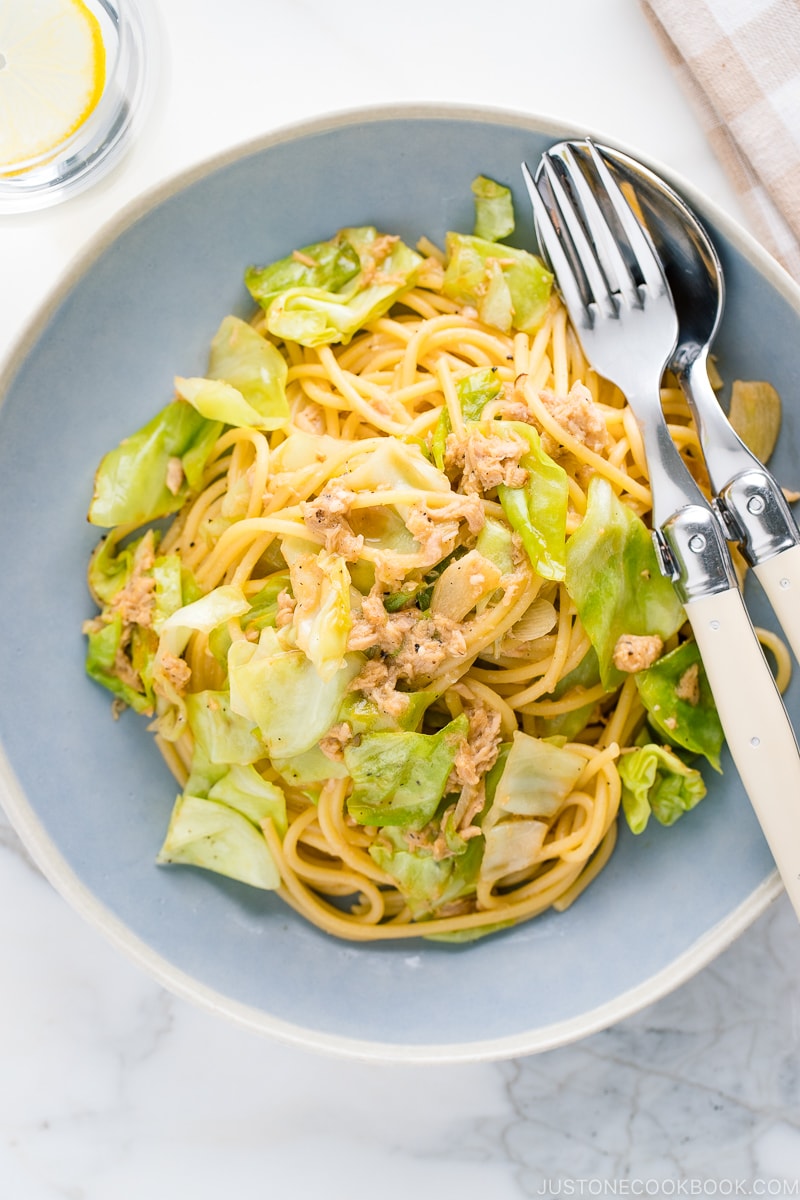
Itadakimasu!
Keep this Miso Butter Pasta recipe in your back pocket now, and throw it together any night of the week when simple is your life mantra.
Cooking for kids? Feel free to sprinkle over with some shaved parmesan. Enjoy!
If you like this miso-infused pasta, check out my creamy miso pasta with tofu and asparagus. It’s vegetarian-friendly!
Other Japanese-Style Pasta Recipes on Just One Cookbook
- Creamy Mushroom and Bacon Pasta
- Classic Mentaiko Pasta
- Ume Shiso Pasta
- Japanese-style Pasta with Shrimp and Broccolini

Wish to learn more about Japanese cooking? Sign up for our free newsletter to receive cooking tips & recipe updates! And stay in touch with me on Facebook, Pinterest, YouTube, and Instagram.

Miso Butter Pasta with Tuna and Cabbage
Ingredients
- 1 Tbsp Diamond Crystal kosher salt (for cooking the pasta)
- 7 oz spaghetti
- 2 cloves garlic
- 3 leaves green cabbage (5 oz, 142 g)
- ½ (5-oz) can albacore tuna (preferably packed in olive oil) (I use 1 can of 2.8-oz, 80-g Japanese-brand canned tuna)
- 1 Tbsp extra virgin olive oil
- freshly ground black pepper
- 1 Tbsp unsalted butter
- 1 Tbsp miso
- ¼ cup reserved pasta water
- 2 tsp soy sauce
- 2 tsp mirin
Instructions
- Gather all the ingredients.

To Cook the Spaghetti
- Start boiling 4 quarts (16 cups, 3.8 L) water in a large pot (I used a 4.5 QT Dutch oven). Once boiling, add 1 Tbsp Diamond Crystal kosher salt and 7 oz spaghetti.

- Stir to make sure the noodles don’t stick to each other. While waiting for the pasta to cook, prepare the other ingredients. Tip: I usually reduce the pasta‘s recommended cooking time by 1 minute since I will continue cooking it in my sauce afterward. You should be able to prepare the other ingredients in 10 minutes while the spaghetti cooks. If you finish cooking the spaghetti first, drain it.

To Prepare the Ingredients
- Meanwhile, prepare the other ingredients. Peel 2 cloves garlic and thinly slice them.

- Remove the tough core of 3 leaves green cabbage and cut into 1-inch-square pieces.

- Drain ½ (5-oz) can albacore tuna (preferably packed in olive oil). Break any big chunks into smaller pieces (optional).

To Cook the Miso Butter Pasta
- Heat 1 Tbsp extra virgin olive oil in a large frying pan over medium heat. While the oil is still not hot yet, add the garlic to start infusing its flavor into the oil. Make sure to coat the garlic with the oil.

- When the garlic is sizzling and well coated with oil, add the cabbage and coat with the oil for 2 minutes or so.

- Add the canned tuna and toss it together with the cabbage.

- Add freshly ground black pepper, 1 Tbsp unsalted butter, and 1 Tbsp miso. Stir to mix well and let the butter melt completely.

- Reserve ¼ cup reserved pasta water and add to the frying pan.

- Shake the pan and mix all the ingredients together. Make sure to dissolve the miso during this time.

- Add 2 tsp soy sauce and 2 tsp mirin.

- When the spaghetti is done cooking, pick up the noodles with a pair of tongs (or you can quickly drain in the sink) and add to the pan. Toss the spaghetti to mix it all together.

- Season the spaghetti with freshly ground black pepper. Taste and add salt if needed. The reserved pasta water I added has enough salt, so I do not add additional salt here. Serve the pasta to individual dishes. Enjoy!




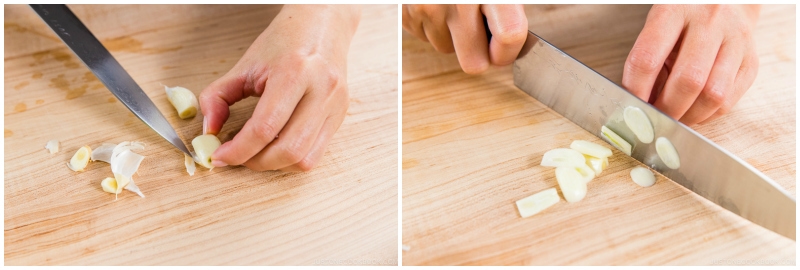



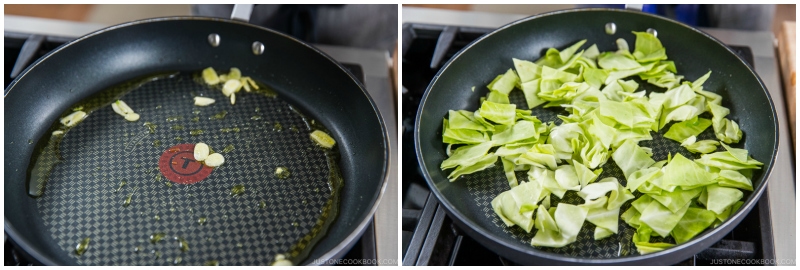

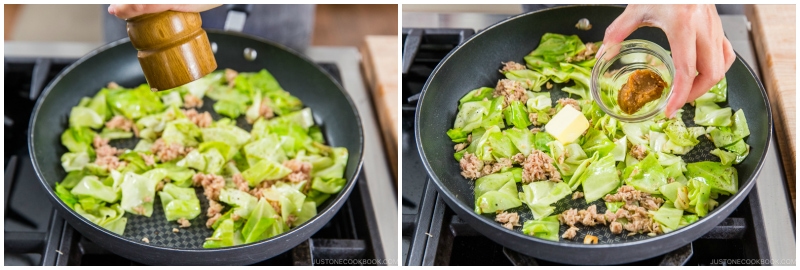



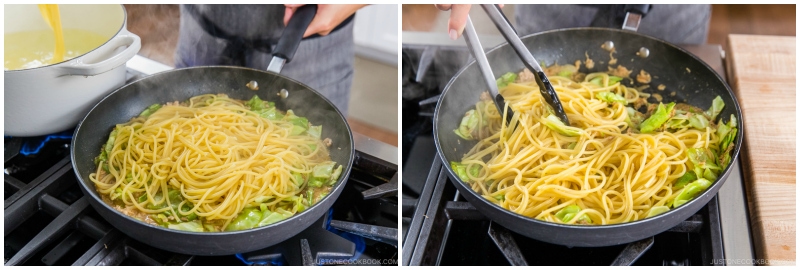
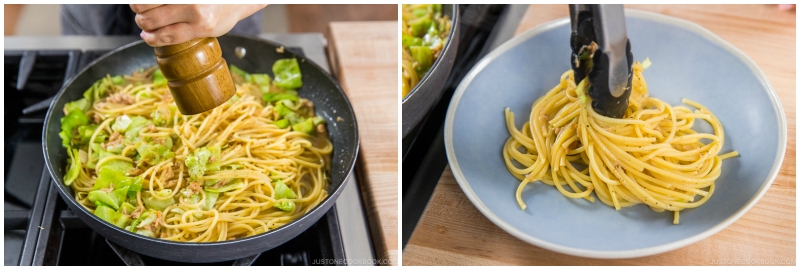










I’m really getting into cooking with miso! Brings such a rich as well as bright flavour to the dish. I also added some zucchini, scallions and a squeeze of lime and it was very nice and green.
As always, thanks Nami!
Hi Julia! Thanks for using this recipe! So happy you liked it! Thank you for your kind feedback! 🙂
What a delicious pasta. It felt healthy, but was flavourful and had a great depth to it. It was easy to make and such refreshing change from a tomato or cream sauce. I highly recommend this tasty dish. It will be part of my regular rotation. Thanks Nami-san for your wonderful recipes and your uplifting e-mails, which I look forward to.
Hi Peckish! I’m so happy you liked this recipe! Thanks so much for trying this dish. 🙂 I’m also happy to hear you enjoy my emails too. xoxo
I was hesitant to try this because I wasn’t sure how the cabbage and tuna would work together. But I knew it was a recipe from justonecookbook so it would likely be good. I was wrong, as it was GREAT 🙂 thank you for another wafu style pasta, as I love mentaiko pasta. Thank you so much for this. I can’t wait to try the mushroom and bacon cream pasta.
Hi Holly! Haha, I’m glad you gave this recipe a try! This pasta is pretty standard in Japan (not my own creation, and I’m not taking all credit here, except seasoning is my style and I assume everyone is slightly different). 😀 Thanks for your kind feedback and I hope you will like the creamy bacon mushroom pasta too!
I was skeptic of the tuna, cabbage, miso combo at first, but I figured, “Nami’s never steered me wrong, what the heck, why not?” Oh boy, was this delicious.
I was taste tested before the soy sauce and mirin to check the saltiness and it was still good! I used 1 tbsp awase miso (which I think is supposed to be saltier than shiro miso) but it was still not too salty. My tuna can was a little bigger, so maybe it picked up the extra salt there.
Overall, super delicious and easy to make, will definitely make this again! I’m usually slow at cooking and this was still a fast one!
Hi Emmeline! AHAHAH Thanks so much for trusting and trying my recipe! 😀 This recipe really surprised me as so many people have made it (and made it again and again) since I published this recipe. Thanks for sharing your cooking experience with us! I’m so happy to hear you enjoyed this recipe!
Oh wow, I didn’t expect a reply! You’re working very hard. ^^
I have been following your blog since I found it in college and wanted to make Japanese food, so it’s trust well earned. 🙂 I’ve never had a recipe turn out bad except when I accidentally used rice vinegar instead of mirin in my gyudon… I was really tired that day, haha.
Most of your recipes have tons of comments, but this one seems to have less, so I hope another positive review will encourage others to try it out!
Hi Emmeline! Haha, Friday (and weekends) are catch up time for me, so I happened to see your email came in. I’m usually a very slow responder as I don’t have much time to write back (but I do respond, even after 2 weeks!). 😀
I’m so happy to hear you have been cooking my recipes for a long time. THANK YOU!!
LOL… that happens. I keep my mirin and sake next to each other in the cabinet and they are the same height so I’ve made a similar mistake before but luckily the damage is less obvious as they are similar condiments (one sweeter). 🙂
Thank you for your kindness. I appreciate your comment very much. xoxo
i was exactly the same! I thougth this sounds odd, but they are the exact ingredients I have and I thought to myself ” Nami never goes wrong, it has to be delicious” – AND IT WAS! Thank you Nami for yet another successful meal!
Hi Sky! AHAHAHAHAHAHA. Thank you Sky! You two are very kind! Don’t get too much trust in me (I’m nervous!). Hahahha. Well, this one is a pretty standard/common recipe in Japan, so I won’t take credit just for myself. Everyone has slightly different variations and you can adapt as you like.
Thanks again for making me feel happy!
Tasty and easy to prepare. My young adult ‘kiddies’ love, two thumbs up. Thkq so much. Garnished with Japanese dried fish flakes so yummy.
Hi Samantha! I’m so happy to hear your family enjoyed this recipe. Thank you for trying this recipe and for your kind feedback. xoxo
Absolutely terrific recipe which made for a great lockdown dinner in Singapore (with my hard-won pasta…stop hoarding people!). Used a red miso from Hikari Miso and it was pretty tasty without any additional salt. Thank you Namiko-san!
Hi Enid! Thank you so much for trying this recipe! I’m glad you tried it with red miso and worked well. Thank you for your kind feedback. I really appreciate it! 🙂
I had to try this dish when I saw the ingredients- it just seemed like a very odd combination. Turns out it’s a fine pasta dish, with the soy sauce and miso adding saltiness similar to cheese. This dish is especially nice for quarantine given that cabbage takes longer than other veggies to go bad, and canned tuna wouldn’t go bad a very long time. I like creamier/saucier pastas, but this was still good (it could’ve been partly because I had more noodles).
I found crushed almonds/walnuts to be a nice topping as well if you happen to have those around
Hi Khang! Thanks so much for trying this recipe! Yeah sorry, this is not your favorite creamy/saucy thick-sauce type of pasta, but we could increase the sauce/soup/broth. 🙂 I like your idea of the crushed almonds/walnuts topping!
I was initially dubious about a tuna and cabbage pasta but my three year old inhaled hers! That butter miso… goes down a treat!
Hi Rebecca! Haha, nice! I’m so happy to hear your 3-year-old enjoyed this recipe! It’s a win, especially when you need to cook a meal fast. 🙂 Thanks so much for your kind feedback!
Just made this tonight and it was delicious! Definitely will make it again.
Hi Rei! Thank you! I’m so happy to hear you enjoyed the recipe. Thanks so much for trying it and for your kind feedback. 🙂
you don’t really say how long to cook the cabbage, so, how long should I cook the cabbage?
Hi Sheila! Probably 6 minutes total. I want to keep my cabbage to have some texture, so by Step 7, the cabbage should be 90% done (for my ideal doneness), and the last 10% should be done cooking with the pasta. Hope this helps…
I always like Japanese dishes, it’s much more healthier. and simple to cook. TQ
Thank you for your kind feedback, Natalie! 🙂
Nami, FYI the ingredients list says 4 Tbsp reserved pasta water (1/2 cup) but in the instructions say to add 1/4 cup (4 Tbsp). Just thought you ought to know.
I’m thinking of trying this recipe with canned salmon.
Hi Suzi! UGH! Thank you so much for bringing this to my attention! 4 Tbsp = ¼ cup = 60 ml. NOT ½ cup. Thank you so much again! Hope you enjoy the recipe! xoxo
Hmmm…how would this be using udon or soba noodles? Husband doesn’t care for tuna…perhaps cooked chicken would work….
Hi Elaine! Sure, they would work too! It’s a pretty flexible recipe. 🙂
Instead of can tuna, use frozen coctail shrimps and add green onions. Yumm
Hi Michie! Oh wow, that sounds delicious! Thanks so much for trying this recipe!
Thank you, Nami-san, for posting this. I plan to make this recipe later this weekend. I just returned from London and am in self quarantine for 14 days so I don’t have fresh produce. I plan to use frozen broccoli. I’m so excited to try this recipe!
Hi Karen-san! I hope you enjoy(ed) this recipe! Please stay safe and healthy.